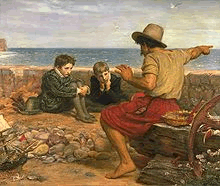 One of my favorite stories growing up was of the day my grandmother met my grandfather. She was in her early 30s – resolutely considered the age of spinsterhood in the time the Communists rose to power in China in the 1940s. She came from an aristocratic family, which rendered her and all the eligible young men she knew the loathsome ‘class enemy’. But what grandma considered even more crippling was the birthmark she had been born with: a blue, vein-like tinge that crept from under her right eye and snaked its way down her cheekbone. She thought it made her look ugly, and no man would want her. But when Mao announced that all unmarried women over the age of 16 had to marry someone from the Communist party, suddenly grandma had no choice but to find a husband. She was introduced to a young man through a matchmaker who proclaimed insensitively, “I understand if this person isn’t suitable because of the mark on her face.” My future grandfather said, “Don’t be ridiculous. Something like that isn’t important.”
One of my favorite stories growing up was of the day my grandmother met my grandfather. She was in her early 30s – resolutely considered the age of spinsterhood in the time the Communists rose to power in China in the 1940s. She came from an aristocratic family, which rendered her and all the eligible young men she knew the loathsome ‘class enemy’. But what grandma considered even more crippling was the birthmark she had been born with: a blue, vein-like tinge that crept from under her right eye and snaked its way down her cheekbone. She thought it made her look ugly, and no man would want her. But when Mao announced that all unmarried women over the age of 16 had to marry someone from the Communist party, suddenly grandma had no choice but to find a husband. She was introduced to a young man through a matchmaker who proclaimed insensitively, “I understand if this person isn’t suitable because of the mark on her face.” My future grandfather said, “Don’t be ridiculous. Something like that isn’t important.”
In the end, my grandparents were happily married for 60 years.
As I grew up and experienced knocks to my self-image, I’d remind myself of this narrative backbone through which I could filter and retain that all-important message: it’s what inside that counts.
That’s what a good story does. It reminds us that being alive is a shared experience, and invites us into the world of another to recognize our own humanity. Generations and cultures collapsed between my grandmother and I whenever stories were shared . They allowed me to imagine myself in her shoes – highlighting similarities, not differences. My most valuable lessons have come in the form of stories because stories tap into our intuitive, human impulse to empathise- the capacity we all have to be able to “feel oneself into the inner life of another person.”*
From a neurological standpoint, human beings’ sense of empathy can be mapped through our cognitive wiring- the way we connect with others is through mirror neurons. That is, your behavior and actions will fire off impulses in MY brain that recognize YOUR behavior and actions – which is the basic brain function of empathy. This function can also improve with practice when we train our ability to listen, to
digest, to interpret, to edit and to finally inhabit. When engaged in storytelling, we are searching something outside of ourselves to embody new meanings.
A simple and effective storytelling exercise I like to use as an ice-breaker is asking students to partner up in pairs and share short personal stories with each other, and then asking them to tell their partner’s story in the first person – as if that story happened to them. The purpose of this activity is to highlight:
– The importance of listening and absorbing information not just in words, but also in the interaction of sharing
– The role of editing in storytelling – how do you choose what information to tell?
– The interpretive process to make something your own
– How do you take on the responsibility of telling somebody else’s story, while maintaining its original essence?
What underpins the technique of storytelling as an artform is its power to enable you to learn even more about yourself than the subject – through the act of doing.
Where the ability to learn is concerned, fear of the unknown can be a stumbling block to receiving new and unfamiliar information. Stories make audiences of all of us, generating openness, curiosity and an embracing of the unknown. Consisting of characters with human flaws that are celebrated, and amongst whom conflict is under the microscope, it is this debilitating fear of the unknown that dissolves in the face of empathy as we engage in storytelling.
When faced with high-stakes moments and devices employed in serialised storytelling such as ‘cliff-hangers’, –we create for us and our audiences the appetite to know “what happens next?” rather than ‘I don’t want to know’ when unexpected life challenges are presented to us. In essence, this is an optimistic frame of mind that creatively drives problem-solving, critical analyses and their application in educational endeavours.
Through penning memoirs about more tumultuous times in my life, I am now extrapolating larger, universal resonances from intensely personal experiences. When I see them land on the page or out loud to a roomful of strangers, my stories can now exist outside myself and serve as a template for reflection in very much the same way that I learnt from my grandmother’s stories: that there exists alternative ways of negotiating the complex realities our brains are unable to process in isolation.
*Heinz Kohut


